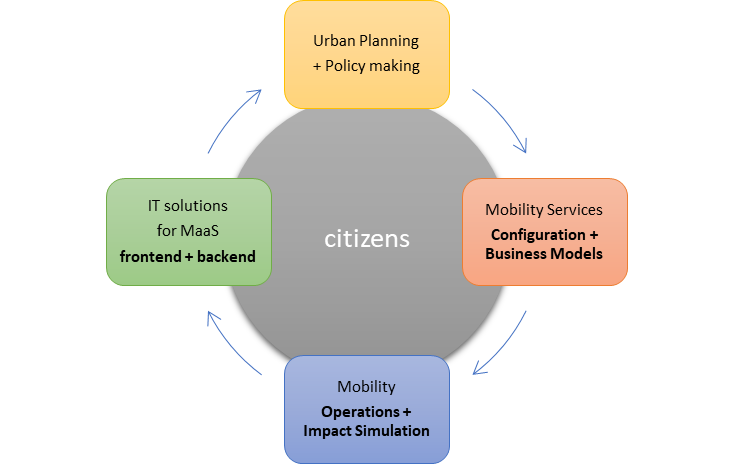Optimized Mobility as a Service
Holistic mobility solutions for the urban periphery
OptiMaaS aims at reducing congestion through better multimodal, environmentally friendly mobility services in the urban periphery and improving the social acceptance of Mobility as a Service (MaaS) offers. Existing spatial structures within the urban periphery have a big impact on the citizens’ mobility options. OptiMaaS develops new methods and processes addressing the needs of public and private mobility actors to provide optimized MaaS offers.
Figure 1 - OptiMaaS integrated approach, © tbw research GesmbH
Project Objectives and Targets
Challenges for city management
The availability of mobility offers and services and the predominant spatial structures, largely determine citizens’ mobility behavior. In particular the urban periphery continues to be heavily car reliant resulting from a low public transport service quality and availability. As a matter of fact, this causes high motorization rates and congestion. Ongoing urbanization provokes land use conflicts particularly concerning of the vast space requirements for parking and streets that go along with car reliance. Facing these trends, the challenge remains for city managements to provide more efficient modes of transport. At the same time, transportation in city periphery needs to become more versatile, demand-responsive accessible for all at low costs and at the same time flexible to be shaped by city policies.
Citizens’ needs
As cities and surrounding areas grow, the price of housing units that are connected to good or excellent transport connections rise significantly. One major reason for urban sprawl are lower housing prices but a challenge often overlooked is the trade-off between residence location costs and mobility costs: Although residential costs in peripheral urban areas are generally lower, one has to ride longer distances to reach work, education, social- or recreation facilities which results in higher expenses for mobility.
Figure 2 - Challenges of urban periphery, © MO.Point GmbH
MaaS solution
Recent efforts to tackle the challenges described above have brought up a new breed of providers for combined mobility services (CMS) and business models. Despite the lack of a commonly agreed definition those MaaS-Systems (Mobility as a Service) are defined as traffic service including public transport in combination with other transport modes (taxi, car-sharing, bike-sharing etc.). This combination is facilitated through the use of IT-Platforms that link the respective service providers and bundle existing mobility offers while at the same time ensuring route optimization following different strategies (most environmentally friendly, fastest, cheapest route, etc.). Although MaaS opens huge opportunities to overcome the urban mobility challenges, there are still open questions limiting advantages for Cities: MaaS has largely been driven forward by digital and ITS industries and the personal transport sectors of car-sharing and taxis. The role of the wider public transport sector appears to have been minimized, which is a major issue for city and regional authorities as mass transit is the backbone of mobility. Therefore, new solution paths need to be developed.
Goals
Based on the current challenges in European cities – especially in urban periphery – OptiMaaS explores and develops new tools, processes and business models in a multi-stakeholder process, focusing on citizens’ needs. By linking the know-how of urban and mobility service planning, public and private mobility operators with IT developers for MaaS, we aim at providing an integrated approach to effectively use and implement MaaS services, where they are needed most.
- The first objective is to identify (1) where and for whom MaaS-offers can be implemented in urban periphery considering geographic, demographic, infrastructural and sociodemographic data and (2) how an adequate MaaS-operator-landscape, can be set up there. This leads to: a) planning-methods to locate mobility points and b) examples for business models and Public-Private Partnerships.
- The second objective is to develop a methodology and testing which kind of mobility services best fit citizens’ demands, which degree of availability is needed and how to best communicate and promote the market. Planned results are: (1) a configuration tool for shared mobility services, (2) click-test dummy for individualized MaaS-IT-solution experiences, (3) examples for service bundles and pricing (e.g., dynamic pricing, purchase of intermodal mobility service / mobility packages via App).
- Third, we will develop new simulation methods to measure the impact of incentives within personalized MaaS-routing policies, both on the individual user behavior and on the mobility system as a whole.
Overall, the OptiMaaS project helps improving the dissemination and social acceptance of MaaS-offers and builds a common ground for new, data-driven governance and city planning policies.
The project OptiMaaS is being implemented as part of the JPI Urban Europe on behalf of the Federal Ministry of Transport, Innovation and Technology (BMVIT) and the Norwegian Research Council under project number 872541.
Start of project: 09 / 2018
Duration: 30 months (end 02/2021)
Project website: https://www.optimaas.eu
Related Project OPTCORA
During the OptiMaaS project the spin-off project OPTCORA was carried out with a similar problem setting. In OPTCORA we have considered the public transport system in the region of Agder, Norway and used the developed simulation framework to evaluate the impact of different public transport measures. For more information, see the project report.







